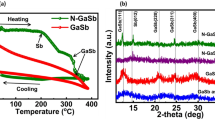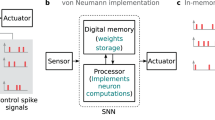Abstract
The implementation of artificial spiking neural network (SNN) usually takes advantage of multiple heterogeneous circuits to mimic either neurons which generate spiking pulses, or synapses which store the weights of event correlations. Here, we design a homogeneous device using Ge-Ga-Sb (GGS) as a phase-change-memory (PCM) material which can do both jobs. The GGS compound shows high stability when used in data storage, such as high working temperature (281°C) and high 10-years data retention temperature (230°C), as well as low resistance drift. Interestingly, when the as-fabricated GGS device is set by iterative narrow-width electric pulses, it first experiences an abrupt resistance drop by two orders of magnitude, followed by a continuous resistance decrease. This unique abrupt-to-progressive transition can be used to mimic both neuronal and synaptic functions, mechanistically enabled by the formation of conductive channels and the continuous growth with the phase separation of crystalline areas. To this end, we propose an all-PCM SNN, which is emulated to have high accuracy (90%) in the standard pattern recognition.

摘要
人工脉冲神经网络通常由多个异质结构的电路单元构成, 其中包括具备积分点火功能来产生脉冲信号的神经元模拟器, 以及具备记忆功能的突触器件. 在本文中, 我们设计了一种能进行“同质集成”的相变存储介质Ge-Ga-Sb(GGS)器件, 该器件能够同时实现神经元和突触的模拟. 在先前的研究中, GGS材料表现出优秀的数据存储功能, 例如它具备较高的工作温度(281°C)、较高的十年数据保存温度(230°C)以及较低的电阻漂移. 当对该器件改用短脉冲电学操作时, GGS器件首先会发生几个数量级的电阻突变, 然后紧接着发生连续的电阻降低. 通过透射电子显微镜发现, 电阻突变是因为电极之间产生了结晶的导电通道, 而电阻缓变是因为导电通道的变粗以及在通道内产生材料分相所致. 这种“突变-缓变”的电阻变化特性既可以用来模拟神经元的积分点火功能, 也可以模拟突触权重的变化. 基于此器件设计的全相变脉冲神经网络, 可以实现高达90%的手写数字识别率.
Similar content being viewed by others
References
Silver D, Schrittwieser J, Simonyan K, et al. Mastering the game of Go without human knowledge. Nature, 2017, 550: 354–359
Yao P, Wu H, Gao B, et al. Face classification using electronic synapses. Nat Commun, 2017, 8: 15199
Wang K, Hu Q, Gao B, et al. Threshold switching memristor-based stochastic neurons for probabilistic computing. Mater Horiz, 2021, 8: 619–629
Mutlu O, Ghose S, Gómez-Luna J, et al. Processing data where it makes sense: Enabling in-memory computation. Microprocessors MicroSyst, 2019, 67: 28–41
Roy K, Jaiswal A, Panda P. Towards spike-based machine intelligence with neuromorphic computing. Nature, 2019, 575: 607–617
Merolla PA, Arthur JV, Alvarez-Icaza R, et al. A million spiking-neuron integrated circuit with a scalable communication network and interface. Science, 2014, 345: 668–673
Seo JS, Brezzo B, Liu Y, et al. A 45 nm CMOS neuromorphic chip with a scalable architecture for learning in networks of spiking neurons. In: 2011 IEEE Custom Integrated Circuits Conference, San Jose, CA, 2011, 1–4
Wang Q, Niu G, Ren W, et al. Phase change random access memory for neuro-inspired computing. Adv Electron Mater, 2021, 7: 2001241
Mulaosmanovic H, Chicca E, Bertele M, et al. Mimicking biological neurons with a nanoscale ferroelectric transistor. Nanoscale, 2018, 10: 21755–21763
Wang Z, Crafton B, Gomez J, et al. Experimental demonstration of ferroelectric spiking neurons for unsupervised clustering. In: 2018 IEEE International Electron Devices Meeting, San Francisco, CA, 2018, 13.3.1–13.3.4
Gupta I, Serb A, Khiat A, et al. Real-time encoding and compression of neuronal spikes by metal-oxide memristors. Nat Commun, 2016, 7: 12805
Yu S, Gao B, Fang Z, et al. A low energy oxide-based electronic synaptic device for neuromorphic visual systems with tolerance to device variation. Adv Mater, 2013, 25: 1774–1779
Prezioso M, Merrikh-Bayat F, Hoskins BD, et al. Training and operation of an integrated neuromorphic network based on metal-oxide memristors. Nature, 2015, 521: 61–64
Liu L, Li Y, Huang XD, et al. Low-power memristive logic device enabled by controllable oxidation of 2D HfSe2 for in-memory computing. Adv Sci, 2021, 8: e2005038
Wang TZ, Xia J, Yang R, et al. Stable retention in SrTiO3/SrRuO3 heterostructure-based memristive devices. Sci China Mater, 2022, doi: https://doi.org/10.1007/s40843-022-2228-3
van de Burgt Y, Lubberman E, Fuller EJ, et al. A non-volatile organic electrochemical device as a low-voltage artificial synapse for neuromorphic computing. Nat Mater, 2017, 16: 414–418
Lenz J, del Giudice F, Geisenhof FR, et al. Vertical, electrolyte-gated organic transistors show continuous operation in the MA cm−2 regime and artificial synaptic behaviour. Nat Nanotechnol, 2019, 14: 579–585
Tuma T, Pantazi A, Le Gallo M, et al. Stochastic phase-change neurons. Nat Nanotech, 2016, 11: 693–699
Cobley RA, Hayat H, Wright CD. A self-resetting spiking phase-change neuron. Nanotechnology, 2018, 29: 195202
Kuzum D, Jeyasingh RGD, Lee B, et al. Nanoelectronic programmable synapses based on phase change materials for brain-inspired computing. Nano Lett, 2012, 12: 2179–2186
Xu M, Mai X, Lin J, et al. Recent advances on neuromorphic devices based on chalcogenide phase-change materials. Adv Funct Mater, 2020, 30: 2003419
Sarwat SG, Kersting B, Moraitis T, et al. Phase-change memtransistive synapses for mixed-plasticity neural computations. Nat Nanotechnol, 2022, 17: 507–513
Zhao R, He M, Wang L, et al. Improved multilevel storage capacity in Ge2Sb2Te5-based phase-change memory using a high-aspect-ratio lateral structure. Sci China Mater, 2022, 65: 2818–2825
Zhang W, Mazzarello R, Wuttig M, et al. Designing crystallization in phase-change materials for universal memory and neuro-inspired computing. Nat Rev Mater, 2019, 4: 150–168
Rao F, Ding K, Zhou Y, et al. Reducing the stochasticity of crystal nucleation to enable subnanosecond memory writing. Science, 2017, 358: 1423–1427
Li XB, Chen NK, Wang XP, et al. Phase-change superlattice materials toward low power consumption and high density data storage: Microscopic picture, working principles, and optimization. Adv Funct Mater, 2018, 28: 1803380
Loke D, Lee TH, Wang WJ, et al. Breaking the speed limits of phase-change memory. Science, 2012, 336: 1566–1569
Qiao C, Bai K, Xu M, et al. Ultrafast crystallization mechanism of amorphous Ge15Sb85 unraveled by pressure-driven simulations. Acta Mater, 2021, 216: 117123
Xu M, Xu M, Miao X. Deep machine learning unravels the structural origin of mid-gap states in chalcogenide glass for high-density memory integration. InfoMat, 2022, 4: e12315
Yang Z, Li B, Wang JJ, et al. Designing conductive-bridge phase-change memory to enable ultralow programming power. Adv Sci, 2022, 9: 2103478
Zhang L, Mai X, Gu R, et al. Three resistance states achieved by nanocrystalline decomposition in Ge-Ga-Sb compound for multilevel phase change memory. Adv Electron Mater, 2021, 7: 2100164
Wu Q, Xu M, Xu K, et al. Increasing the atomic packing efficiency of phase-change memory glass to reduce the density change upon crystallization. Adv Electron Mater, 2018, 4: 1800127
Fang W, Song S, Zhao J, et al. Outstanding phase-change behaviors of GaGeSbTe material for phase-change memory application. Mater Res Bull, 2022, 149: 111731
Chien WC, Cheng HY, Brightsky M, et al. Reliability study of a 128Mb phase change memory chip implemented with doped Ga-Sb-Ge with extraordinary thermal stability. In: 2016 IEEE International Electron Devices Meeting, San Francisco, CA, 2016, 21.1.1–21.1.4
Redaelli A, Gandolfo A, Samanni G, et al. Improving Ge-rich GST ePCM reliability through BEOL engineering. In: ESSDERC 2021 — IEEE 51st European Solid-State Device Research Conference Grenoble, France, 2021, 231–234
Redaelli A, Petroni E, Annunziata R. Material and process engineering challenges in Ge-rich GST for embedded PCM. Mater Sci Semiconductor Processing, 2022, 137: 106184
Kiouseloglou A, Navarro G, Sousa V, et al. A novel programming technique to boost low-resistance state performance in Ge-rich GST phase change memory. IEEE Trans Electron Devices, 2014, 61: 1246–1254
Cheng HY, Wu JY, Cheek R, et al. A thermally robust phase change memory by engineering the Ge/N concentration in (Ge,N)xSbyTez phase change material. In: 2012 International Electron Devices Meeting, San Francisco, CA, 2012, 31.1.1–31.1.4
Hu Y, Zou H, Yuan L, et al. Improved phase change behavior of Sb2Se material by Si addition for phase change memory. Scripta Mater, 2016, 115: 19–23
Wright CD, Hosseini P, Diosdado JAV. Beyond von-Neumann computing with nanoscale phase-change memory devices. Adv Funct Mater, 2013, 23: 2248–2254
Zhang W, Mazzarello R, Ma E. Phase-change materials in electronics and photonics. MRS Bull, 2019, 44: 686–690
Sebastian A, Le Gallo M, Krebs D. Crystal growth within a phase change memory cell. Nat Commun, 2014, 5: 4314
Lanza M, Waser R, Ielmini D, et al. Standards for the characterization of endurance in resistive switching devices. ACS Nano, 2021, 15: 17214–17231
Pirovano A, Lacaita AL, Pellizzer F, et al. Low-field amorphous state resistance and threshold voltage drift in chalcogenide materials. IEEE Trans Electron Devices, 2004, 51: 714–719
Lavizzari S, Ielmini D, Sharma D, et al. Reliability impact of chalcogenide-structure relaxation in phase-change memory (PCM) cells—Part II: Physics-based modeling. IEEE Trans Electron Devices, 2009, 56: 1078–1085
Mitra M, Jung Y, Gianola DS, et al. Extremely low drift of resistance and threshold voltage in amorphous phase change nanowire devices. Appl Phys Lett, 2010, 96: 222111
Boniardi M, Ielmini D, Lavizzari S, et al. Statistics of resistance drift due to structural relaxation in phase-change memory arrays. IEEE Trans Electron Devices, 2010, 57: 2690–2696
Putero M, Coulet MV, Ouled-Khachroum T, et al. Unusual crystallization behavior in Ga-Sb phase change alloys. APL Mater, 2013, 1: 062101
Bohte SM, Kok JN, La Poutré H. Error-backpropagation in temporally encoded networks of spiking neurons. Neurocomputing, 2002, 48: 17–37
Acknowledgements
This work was supported in part by the National Science and Technology Major Project of China (2017ZX02301007-002). Xu M acknowledges the National Natural Science Foundation of China (62174060). Miao X acknowledges the funding for Hubei Key Laboratory of Advanced Memories.
Author information
Authors and Affiliations
Contributions
Xu M and Miao X designed the project; Lin J and Mai X conducted the experiments with the support from Tong H; Zhang D and Wang K performed the simulations of SNN with the support of He Y and Li Y; Lin J and Xu M wrote the paper. All authors contributed to the general discussion.
Corresponding author
Additional information
Jun Lin obtained his Bachelor’s and Master’s degrees from the School of Optical and Electronic Information, Huazhong University of Science and Technology, Wuhan, China. His main research focuses on the neuromorphic application of phase change memory based on Ge-Ga-Sb materials.
Xianliang Mai is currently a PhD student at the School of Optical and Electronic Information, Huazhong University of Science and Technology. His research interest focuses on the threshold switching selectors based on chalcogenides and their applications.
Dayou Zhang received his BS degree (2016) and MS degree (2018) of financial mathematics from Xi’an Jiaotong-Liverpool University and he is now a PhD student at Huazhong University of Science and Technology. His research interests include neuromorphic computing, resistive memory, spiking neural networks, and 2D materials.
Ming Xu is a professor and the department chair of microelectronics at Huazhong University of Science and Technology, China. He received his BS and MS degrees from Fudan University (China) in 2005 and 2008, and PhD degree from the Johns Hopkins University (USA) in 2013. Sponsored by the Humboldt Foundation, he worked as a postdoc researcher at RWTH Aachen University (Germany) during 2013–2016. His research focuses on the phase-change materials and chalcogen-based memristors for memory and computing applications.
Conflict of interest
The authors declare that they have no conflict of interest.
Rights and permissions
About this article
Cite this article
Lin, J., Mai, X., Zhang, D. et al. Design of all-phase-change-memory spiking neural network enabled by Ge-Ga-Sb compound. Sci. China Mater. 66, 1551–1558 (2023). https://doi.org/10.1007/s40843-022-2283-9
Received:
Accepted:
Published:
Issue Date:
DOI: https://doi.org/10.1007/s40843-022-2283-9




